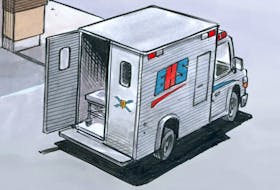LABRADOR WEST, N.L.
It’s hard to believe that another season of trapping is once again upon us in Labrador. The lifestyle, the busy schedules that most folks among us seem to be tied too, and the pace that our lives seem to be following, sees another season jump out at us before we even realize it.
Trapping has been a part of the lifestyle and culture of Labradorians’ for eons of time. The skills and efforts attached to the trapping efforts of the early trappers were clearly born out of necessity.

The furs that were harvested were needed for clothing and for shelters that were survival-based in their pursuit. Trapping was much different than it is today. The trappers would pack everything they needed on their backs and head into the country, often for several months at a time, travelling alone and totally unsupported with only the necessities of survival strapped on their backs.
Their families were left at home to fend for themselves with whatever meager food and supplies that they would have been fortunate enough to have for these winter months. They were also faced with no communications to know if the trapper was okay, or when or if, he would return.
The need for fur for their ultimate survival was the first priority and with the arrival of the European demand for furs, it was a given that they worked harder, went further and took more chances to get more fur to have to sell and trade to buy newly available items that would make life a bit easier for them.
Although trapping is still a very traditional craft by folks from the Big Land, it has sure changed. Travel through the country is supported by quality snowmobiles, sleighs, and precision; quick kill traps and quality winter clothing to keep warm in the harshest of conditions; GPS technology and satellite tracking if you are in trouble are all in hand for the trapper’s time on the land.
Education courses with extensive hands-on instruction are also mandatory for all participants before they can be issued a trappers license. Animal identification, trapping skills, the correct methods of setting the traps and the use of traps that are delivering quick and humane kills are part of the necessary criteria to become a trapper.
For the trappers that have headed into the country this fall, there is a different set of reasons to be out there than the forefathers of generations long since passed. The necessity for survival is no longer the driving force. The desire to be in the country and participating in an age-old tradition, the call of the wild and the lifestyle that survived, as the new generations have taken over, is a driving force.
Maintaining the closeness to the country and all the adventure that it holds is an important part of the annual season and keeping old, cultural ties and family traditions, is many times, an important part of the driving force for many who are still trapping. In many cases, its not about the money, (good thing), its about tradition, culture and being challenged by the many secrets of the Big Land, the many creatures, including the trapper, who call it home.
This 2018 version of our local trapping season has already begun. Beaver, otter, and muskrat opened on Oct. 15. Marten, fox, lynx, wolf, mink, weasel and squirrel on Nov. 1.

All of the experience and knowledge that each of the trappers have accumulated over their years trapping, whether still rookies or seasoned veterans is factored in to the start of each season.
There are always opinions of what species will be in good numbers and what species will be on the decline based on this knowledge. The price of this years harvest is also up for debate, as always, no one will really know until their furs hit the sale and the price is offered. It’s as it has always been with trapping, wait and see.
At the end of each day, and the end of each season there is often little doubt after the math is done, the question that arises is often the same — why did we do that?
The answer too, is often the same as well, and no matter what the math says, trappers go trapping. The price of fur, the cold days in the country, and the wet and frozen feet and hands are all inconsequential. Carrying on this age old tradition and everything that goes with it is in the DNA of those among us who call themselves trappers, simply because it’s something that matters for so many reasons.
More by Gary Shaw:









